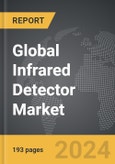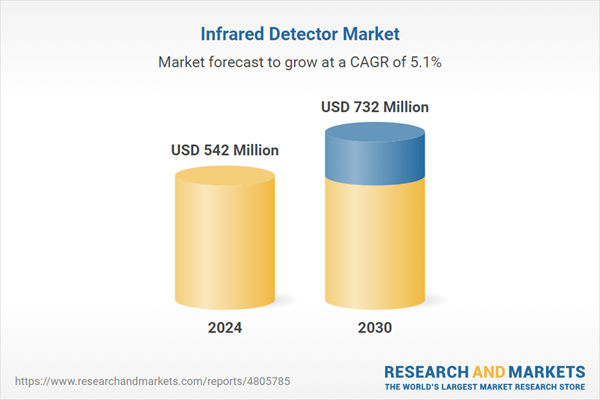Global Infrared Detector Market - Key Trends & Drivers Summarized
What Is an Infrared Detector and How Does It Work?
An infrared detector is a device that is capable of detecting infrared radiation to convert it into a measurable form. Essentially, these detectors are pivotal in systems that require thermal imaging, motion detection, and heat sensing. There are several types of infrared detectors, including cooled and uncooled detectors. Cooled detectors offer superior sensitivity and performance in environments requiring the detection of very slight differences in temperature. On the other hand, uncooled detectors are typically used in industrial and environmental applications where extreme sensitivity is not as crucial. The working principle of these detectors involves the absorption of infrared radiation, which causes changes in their physical properties - changes that are then measured and translated into data. The versatility of infrared detectors has led to their use in diverse fields such as astronomy, military and defense, healthcare, and automotive industries.What Innovations Are Steering the Infrared Detector Technology Forward?
Technological advancements are continually shaping the infrared detector market. Recent innovations include enhancements in sensor design, which have increased the sensitivity and accuracy of infrared detectors. The integration of nanotechnology has led to the development of smaller, more efficient, and less expensive sensors, making them accessible for broader applications. Additionally, advancements in materials science have introduced novel materials like graphene and black silicon, which offer better noise performance and higher quantum efficiency. These technological improvements not only enhance the performance of infrared detectors but also extend their operational lifetime and reliability. Another significant advancement is the development of hybrid detectors that combine the attributes of different technologies to optimize performance across a range of environmental conditions.How Are Market Demands Shaping the Development of Infrared Detectors?
Market demands across various sectors are significantly influencing the development and enhancement of infrared detector technologies. In the security and surveillance industry, there is a high demand for high-resolution and low-light imaging capabilities to improve nighttime surveillance activities. The automotive industry requires robust and reliable detectors for driver-assistance systems and autonomous vehicles to ensure safety in low visibility conditions. Additionally, as global industrial automation progresses, the need for infrared detectors in quality control processes and equipment monitoring is increasing. These demands are pushing manufacturers to innovate and develop more specialized and sophisticated infrared detectors that can meet the stringent requirements of modern applications.What Drives the Growth of the Infrared Detector Market?
The growth in the Infrared Detector market is driven by several factors, rooted in both technological advancements and shifting market demands. The increased adoption of infrared detectors in military applications, especially for night vision and surveillance, continues to be a significant growth driver. Additionally, stringent safety regulations in industries such as automotive, where infrared detectors are increasingly incorporated in advanced driver-assistance systems (ADAS), stimulate further market expansion. Consumer behavior has also shifted towards more safety-conscious and energy-efficient solutions, boosting the deployment of infrared technologies in residential and commercial building applications for security and energy management. Furthermore, ongoing technological innovations that reduce the cost and size of these detectors while enhancing their functionality are making them indispensable in newer, emerging applications, ensuring sustained market growth.Report Scope
The report analyzes the Infrared Detector market, presented in terms of market value (USD). The analysis covers the key segments and geographic regions outlined below.- Segments: Technology (Uncooled, Cooled); Wavelength (LWIR, NIR & SWIR, MWIR); Application (People & Motion Sensing, Temperature Measurement, Security & Surveillance, Gas & Fire Detection, Spectroscopy & Biomedical Imaging, Scientific Applications).
- Geographic Regions/Countries: World; United States; Canada; Japan; China; Europe (France; Germany; Italy; United Kingdom; and Rest of Europe); Asia-Pacific; Rest of World.
Key Insights:
- Market Growth: Understand the significant growth trajectory of the Uncooled Technology segment, which is expected to reach US$489.4 Million by 2030 with a CAGR of 4.7%. The Cooled Technology segment is also set to grow at 6.1% CAGR over the analysis period.
- Regional Analysis: Gain insights into the U.S. market, valued at $145.7 Million in 2024, and China, forecasted to grow at an impressive 4.9% CAGR to reach $115.8 Million by 2030. Discover growth trends in other key regions, including Japan, Canada, Germany, and the Asia-Pacific.
Why You Should Buy This Report:
- Detailed Market Analysis: Access a thorough analysis of the Global Infrared Detector Market, covering all major geographic regions and market segments.
- Competitive Insights: Get an overview of the competitive landscape, including the market presence of major players across different geographies.
- Future Trends and Drivers: Understand the key trends and drivers shaping the future of the Global Infrared Detector Market.
- Actionable Insights: Benefit from actionable insights that can help you identify new revenue opportunities and make strategic business decisions.
Key Questions Answered:
- How is the Global Infrared Detector Market expected to evolve by 2030?
- What are the main drivers and restraints affecting the market?
- Which market segments will grow the most over the forecast period?
- How will market shares for different regions and segments change by 2030?
- Who are the leading players in the market, and what are their prospects?
Report Features:
- Comprehensive Market Data: Independent analysis of annual sales and market forecasts in US$ Million from 2024 to 2030.
- In-Depth Regional Analysis: Detailed insights into key markets, including the U.S., China, Japan, Canada, Europe, Asia-Pacific, Latin America, Middle East, and Africa.
- Company Profiles: Coverage of players such as Excelitas Technologies Corporation, FLIR Systems, Inc., Hamamatsu Photonics KK, Honeywell International, Inc., Murata Manufacturing Co., Ltd. and more.
- Complimentary Updates: Receive free report updates for one year to keep you informed of the latest market developments.
Some of the 43 companies featured in this Infrared Detector market report include:
- Excelitas Technologies Corporation
- FLIR Systems, Inc.
- Hamamatsu Photonics KK
- Honeywell International, Inc.
- Murata Manufacturing Co., Ltd.
- Nippon Carbon Co., Ltd.
- Omron Corporation
- Raytheon Company
- Sofradir Group
- Texas Instruments, Inc.
This edition integrates the latest global trade and economic shifts into comprehensive market analysis. Key updates include:
- Tariff and Trade Impact: Insights into global tariff negotiations across 180+ countries, with analysis of supply chain turbulence, sourcing disruptions, and geographic realignment. Special focus on 2025 as a pivotal year for trade tensions, including updated perspectives on the Trump-era tariffs.
- Adjusted Forecasts and Analytics: Revised global and regional market forecasts through 2030, incorporating tariff effects, economic uncertainty, and structural changes in globalization. Includes historical analysis from 2015 to 2023.
- Strategic Market Dynamics: Evaluation of revised market prospects, regional outlooks, and key economic indicators such as population and urbanization trends.
- Innovation & Technology Trends: Latest developments in product and process innovation, emerging technologies, and key industry drivers shaping the competitive landscape.
- Competitive Intelligence: Updated global market share estimates for 2025, competitive positioning of major players (Strong/Active/Niche/Trivial), and refined focus on leading global brands and core players.
- Expert Insight & Commentary: Strategic analysis from economists, trade experts, and domain specialists to contextualize market shifts and identify emerging opportunities.
Table of Contents
Companies Mentioned (Partial List)
A selection of companies mentioned in this report includes, but is not limited to:
- Excelitas Technologies Corporation
- FLIR Systems, Inc.
- Hamamatsu Photonics KK
- Honeywell International, Inc.
- Murata Manufacturing Co., Ltd.
- Nippon Carbon Co., Ltd.
- Omron Corporation
- Raytheon Company
- Sofradir Group
- Texas Instruments, Inc.
Table Information
| Report Attribute | Details |
|---|---|
| No. of Pages | 193 |
| Published | December 2025 |
| Forecast Period | 2024 - 2030 |
| Estimated Market Value ( USD | $ 542 Million |
| Forecasted Market Value ( USD | $ 732 Million |
| Compound Annual Growth Rate | 5.1% |
| Regions Covered | Global |









